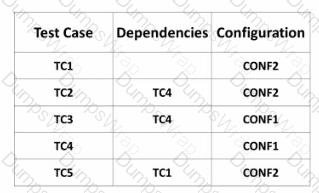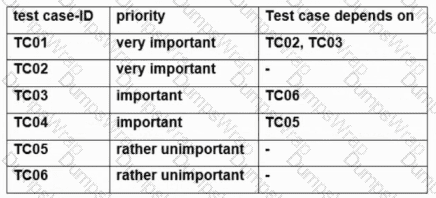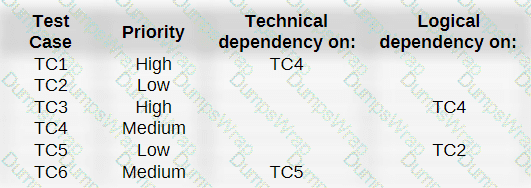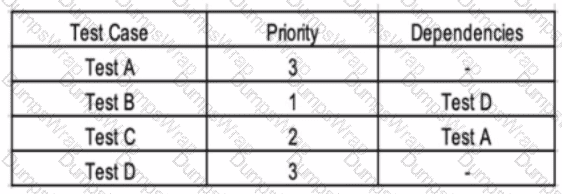ISTQB Certified Tester Foundation Level (CTFL v4.0) Questions and Answers
What role in a formal or technical review should mediate between different opinions to ensure an effective review?
Which of the following is NOT a typical debugging activity when a failure is triggered by dynamic testing?
Which of the following is NOT an experience-based technique?
You are working in an agile team on the creation of software for use in robotic assistance systems that support industrial manufacturing processes. You are currently in the effort estimation phase using planning poker. In the current sprint, three user stories are to be implemented:
In a museum there are staggered entrance fees:
Free admission: children under 14 years
Reduced admission: young people aged 14 and under 18, retiree, students and welfare recipients
Regular price: all other persons
Which of the following four options describes the minimum set of test data that reaches 100% coverage of all valid equivalence classes for the admission fees?
Which ONE of the following is a CORRECT example of the purpose of a test plan?
Which ONE of the following options BEST describes the purpose of confirmation testing versus regression testing?
Which of the following statements about impact of DevOps on testing is CORRECT?
Which of the following statements about error guessing is true?
Which ONE of the following options MOST ACCURATELY describes statement testing?
Which of the following examples represents System Integration testing?
Which of the following statements best describe Behavior-Driven Development (BDD)?
Which of the following about typical information found within a test plan is FALSE?
Which ONE of the following statements is correct?
Which of the following is an example of scenario-oriented acceptance criteria?
Which of the following options should NOT be used for writing acceptance criteria?
Which description reflects aspects of checklist-based testing?
Out of the following. what is not needed to specify in defect report?
Which of the following statements is true?
A company wants to reward each of its salespeople with an annual bonus that represents the sum of all the bonuses accumulated for every single sale made by that salesperson. The bonus for a single sale can take on the following four values: 3%, 5%, 7% and 10% (the percentage refers to the amount of the single sale). These values are determined on the basis of the type of customer (classified as "Basic" or "Premium") to which such sale was made, and on the amount of such sale classified into the following three groups G1, G2 and G3:
• [G1]: less than 300 euros
• [G2]: between 300 and 2000 euros
• [G3]: greater than 2000 euros
Which of the following is the minimum number of test cases needed to cover the full decision table associated with this scenario?
An e-commerce site accepts credit cards for processing the payment. The payment processing form has a field for the amount of money to be deducted. The minimum amount of money that can be processed is $10. The credit cards have a limit of $5,000 (Five Thousand). Assume that only integers can be accepted as inputs. Which of the following set of boundary values you will choose for EFFICIENT testing for the amount of money that can be spent?
Which of the following statements about re-testing and regression testing are TRUE?
I Re-testing should be performed after a defect is fixed.
II Regression testing should always be performed after a defect is fixed.
III. Re-testing and regression testing may be performed at any test level.
IV Regression testing may include functional, non-functional and structural testing.
V. Re-testing should be included in the debugging activity.
A financial institution is to implement a system that calculates the interest rates paid on investment accounts based on the sum invested.
You are responsible for testing the system and decide to use equivalence partitioning and boundary value analysis to design test cases. The requirements describe the following expectations:
Investment range| Interest rate
R500 to RIO 00010%
RIO 001 to R50 00011%
R50 001 to RlOOOOO12%
RIOOOOl to R500 000| 13%
What is the minimum number of test cases required to cover all valid equivalence partitions for calculating the interest?
Which of the following statements best describes how configuration management supports testing?
A state transition diagram describes a control system’s behavior in different operational modes. The initial state is “NORMAL MODE”.
Which ONE of the following test cases covers an INVALID sequence?
The following rules determine the annual bonus to be paid to a salesman of a company based on the total annual amount of the sales made (referred to as TAS).
If the TAS is between 50k€ and 80k€, the bonus is 10%. If the TAS exceeds 80k€ by a value not greater than 40k€, the bonus is 15%. Finally, if the TAS
exceeds the maximum threshold which entitles to a 15% bonus, the bonus is 22%.
Consider applying equivalence partitioning to the TAS (Note: 1k€ = 1000 euros).
Which one of the following answers contain only test cases that belong to the same equivalence partition?
Which of the following BEST describes a benefit of test automation?
Which of the types of test tools noted below BEST describes tools that support reviews?
A class grade application for instructors assigns letter grades based on students' numerical grades.
The letter grades for different numerical grades should be:
Above 89, up to 100 - A
Above 79, up to 89 • B
Above 69, up to 79 • C
Above 59, up to 69 - D
Below 60- F
Which of the following sets of test inputs would achieve the relatively highest equivalence partition coverage?
A test manager defined the following test levels in her test plan; Component, System and Acceptance.
Which Software Development lifecycle is the Test Manager most likely following?
Which of the following is NOT an objective of testing?
Which of the following statements BEST describes the shift-left approach in software testing?
Which of the following statements about static testing and dynamic testing is TRUE?
Which of the following statements about branch coverage is true?
Which of the following statements is NOT true about Configuration management and software testing?
Which of the statements on confirmation testing and regression testing is correct?
Which of the following statements is TRUE?
In what way do Configuration Management effects testing?
Which of the following statements is an example of testing contributing to higher quality?
A typical objective of testing is to
You need to test the login page of a web site. The page contains fields for user name and password. Which test design techniques are most appropriate for this case?
Which ONE of the following work products TYPICALLY belongs to test execution?
Which of the following statements about Experience Based Techniques (EBT) is correct?
What type of testing measures its effectiveness by tracking which lines of code were executed by the tests?
A software application incorrectly provided customers discounts of 50% off their total purchases if the purchases exceeded S100. It was discovered through an audit that the discount should have been only 5% off these purchases. A root cause analysis uncovered that the requirements Incorrectly stated 50% instead of 5% in this scenario.
Which of the following MOST accurately reflects this scenario?
You are testing the latest version of an air-traffic control system prior to production deployment using exploratory testing. After following an unusual sequence of input steps, the system crashes. After the crash, you document a defect report with the following information:
•Title: System crashes unexpectedly during input.
•Brief summary: System crashes when an unusual sequence of inputs is used.
•Version: V1.001
•Test: Exploratory testing prior to production deployment
•Priority: Urgent
•Risk: High
•References: Screenshot of crashed application
What critical Information Is missing from this report?
Which statement corresponds to one of the 7 principles of testing?
Select exactly one option (1 out of 4)!
Which ONE of the following elements is TYPICALLY used to guide testing during exploratory testing?
Which of the following is NOT a deciding factor m determining the extent of testing required?
Which of the following types of tools is BEST suited for determining source code compliance with the guidelines provided by a coding standard?
Match the Work Product with the category it belongs to:
Work Product: 1. Risk register 2 Risk information
3. Test cases
4. Test conditions
Category of work products:
A requirement specifies that if the total amount of sales (TAS) made during the year by a corporate seller is 300,000€ or more, the bonus that must be paid to the seller is 100% of a certain amount agreed upon at the beginning of the year. The software contains a fault as it implements this requirement with the decision "IF (TAS = 300,000)" instead of "IF (TAS >= 300.000)". The application of the 3-value boundary value analysis to this problem consists of the following three test cases (TAS is an integer variable):
TC1 = 299,999 TC2=300,000 TC=300,001
Which of the following statements is TRUE?
Given the following statements:
1.It can prevent defects by manual examination of the functional specification
2.It is effective since it can be performed very early in the software development life cycle
3.It can detect the failures in the running application
4.It can help eliminate defects in user stories
5.It can verify externally visible behaviors
Which set of statements represent values ONLY for static testing?
For each test case to be executed, the following table specifies its dependencies and the required configuration of the test environment for running such test case:

Assume that C0NF1 is the initial configuration of the test environment Based on this assumption, which of the following is a test execution schedule that is compatible with the specified dependencies and allows minimising the number of switches between the different configurations of the test environment^
Which of the following is an INCORRECT statement about the benefit of traceability between the test basis and test work products?
Given the following user story for the development of an online shoe store:
"As a customer, I want to be able to filter shoes by color so that I see, for example, only red shoes in the selection."
Which of the following positive test cases BEST fits to the user story?
Which of the following is an advantage of the whole team approach?
Metrics can be collected during and at the end of testing activities to assess which of the following?
i. Progress against the planned schedule and budget.
II. Current quality of the test object.
Hi. Adequacy of the test approach.
iv. Effectiveness of the test activities with respect to the objectives.
v. All the above.
Select the correct answer:
Use Scenario 1 “Happy Tomatoes” (from the previous question).
Using the Boundary Value Analysis (BVA) technique (in its two-point variant), identify the set of input values that provides the HIGHEST coverage.
Which of the following is a key characteristic of informal reviews?
Which is an advantage of using testers that are independent from the development team?
Which of the following options is correct with respect to the differentiation of black-box techniques, white-box techniques, and experience-based testing?
The following table shows six test cases TC01 to TC06 with their priorities and dependencies.

Schedule the test execution of the specified test case set according to the priorities and dependencies. Since the test time is very tight, the number of test cases should be minimized as much as possible, but all very important test cases must be included.
Which of the following statements is correct?
Which of the following answers describes a reason for adopting experience-based testing techniques?
Which ONE of the following roles is responsible for mediating, managing time, and generating a safe review environment in which everyone can speak freely?
Your manager asked you when testing will be complete. In order to answer this question, you'll most likely use:
Which of the following can be considered a VALID exit criterion?
I Estimates of defect density or reliability measures.
II. The completion and publication of an exhaustive Test Report.
III. Accuracy measures, such as code, functionality or risk coverage.
IV Residual risks such as lack of code coverage in certain areas.
In addition to thorough testing of the requirements specification, a development team aims to involve users as early as possible in the development process, using practices such as prototyping, to ensure that the software systems being developed will meet the users' expectations. This approach is especially useful at mitigating the risks associated with one of the seven testing principles, which one?
The tests at the bottom layer of the test pyramid:
Given the following state model of sales order software:
PLACED -> IN PRODUCTION
IN PRODUCTION -> CANCELLED
IN PRODUCTION -> SHIPPED
SHIPPED -> INVOICED
INVOICED -> CANCELLED
CANCELLED -> PLACED
Which of the following sequences of tran-sitions provides the highest level of tran-sition coverage for the model (assuming you can start in any state)?
Which of the following statements about static testing is true?
Which of the following BEST defines risk level?
You are testing a room upgrade system for a hotel. The system accepts three differed types of room (increasing order of luxury): Platinum. Silver and Gold Luxury. ONLY a Preferred Guest Card holder s eligible for an upgrade.
Below you can find the decision table defining the upgrade eligibility:
What is the expected result for each of the following test cases?
Customer A: Preference Guest Card holder, holding a Silver room
Customer B: Non Preferred Guest Card holder, holding a Platinum room
Given the following priorities and dependencies for these test cases:

Which of the following test execution schedules BEST takes into account the priorities and technical and logical dependencies?
Which of the following statements about the testing quadrants is TRUE?
In which of the following cases you would NOT execute maintenance testing?
Consider the following testing levels:
1) Component Testing
2) Integration Testing
3) System Testing
4) Acceptance Testing
Which of the following statements is true?
Which sequence of state transitions is INCORRECT in accordance with the following description?
To provide for disaster recovery, a system (designated as A) has been provided with a backup system (designated as B). Only one of them can be active at a time. When A goes down, B becomes active. When A comes back up then B becomes inactive and A becomes active again. However, when A is down and B also goes down then a message is sent to the system administrator. After this once A comes back up, A becomes active or if B comes up then B becomes Active.
Shripriya is defining the guidelines for the review process implementation in her company. Which of the following statements is LEAST likely to have been recommended by her?
Which of the following is a role that is usually responsible for documenting the findings (e.g., action items, decisions, recommendations) made by the review team as part of a typical formal review?
Which of the following statements best describes an advantage of the whole team approach?
Which of the following statements about TDD, BDD and ATDD is TRUE?
What is test oracle?
Consider a given test plan which, among others, contains the following three sections: "Test Scope", "Testing Communication", and "Stakeholders". The features of the test object to be tested and those excluded from the testing represent information that is:
Select which of the following statements describe the key principles of software testing?
i. Testing shows the presence of defects, not their absence.
ii. Testing everything Is possible.
iii. Early testing Is more expensive and is a waste of time.
iv. Defects cluster together.
v. Testing is context dependent.
vi. Beware of the pesticide paradox.
vii. Absence of errors is a fallacy.
Select the correct answer:
Which of the following statements regarding the testing quadrants model is correct?
Which ONE of the following statements about maintenance testing is CORRECT?
Which of the following is a possible reason for introducing a defect in software code?
Which statement about use case testing is true?
Given the following User Story: "As an online customer, I would like to be able to cancel the purchase of an individual item from a shopping list so that it only displays the relevant items, in less than 1 second", which of the following can be considered as applicable acceptance test cases?
I.Click on my online shopping list, select the unwanted Item, delete the unwanted item, the unwanted Item is deleted from the shopping list in less than 1 second.
ii.Click on my online shopping list, select all the items, delete all the items, the unwanted items are deleted from the shopping list in less than 1 second.
iii.Tab to the online shopping list and press enter, select the unwanted item, delete the unwanted item, the unwanted item is deleted from the shopping list In less than 1 second.
Iv. Click on the checkout button, select the payment method, make payment, confirmation received of payment and shipping date.
v. Click on my shopping list, select the unwanted Item, delete the unwanted item, the unwanted item is deleted from the shopping list.
Select the correct answer:
Which of the following statements is assigned correctly as a project or product risk?
Which of the following statements is CORRECT about the value added by a tester to release planning?
Which of the following exemplifies how a software bug can cause harm to a company?
Which of the following is true about Oracles?
Mark the correct sentences:
* Defects are a result of environmental conditions and are also referred to as "Failures"
* A human mistake may produce a defect
* A system mil totally fail to operate correctly when a failure exists in it
* When a defect exists in a system it may result in a failure
* Defects occur only as a result of technology changes
During which main group of test activity are the following tasks performed?
•Checking test results and logs against specified coverage criteria.
•Assessing the level of component or system quality based on test results and logs.
•Determining whether more tests are needed.
Select the correct answer:
Given the following review types and review characteristics:
a.Pair review
b.Walkthrough
c.Technical review
d.Inspection
1.Formal
2.Informal
3.Purposes include evaluating the quality of the work product under review and generating new ideas (e.g., brainstorming solutions)
4.Purposes include Improving the software product and training the review participants
Which of the following BEST matches the review type with the review characteristic?
You are a tester working on a critical project. Based on the risk analysis you execution? Priority 1 is the highest and Priority 3 is the lowest priority.

Software was found lo take much more time than the stated requirement of less than one second to save a file. Upon investigation it was found that there was an unnecessary check inside a loop which was slowing down the file-save operation. The software not being able to meet the desired response time is an example of
Which of the following provides the BEST description of statement coverage?
A system computes prices for bus tickets. The price depends on
- the passenger type (baby, child, adult, senior citizen, student, military)
- the travelling type (as single or in a group)
- the distance (zone 1. 2. 3)
- the kind of transport (ordinary, express)
Which of the following test techniques is the most appropriate one for testing the price computation?
Which of the following BEST distinguishes the terms "validation" and "verification"?
In the newest version of payroll system number of changes were made. As a tester you got a task to perform regression and confirmation tests. Which of the following project activities are related to confirmation testing?
A QA manager of a start-up company needs to implement within a week a low cost incident management tool. Which of the following is the best option?
Which of the following activities are part of test planning?
I) Setting the entry and exit criteria
II) Determining the validity of bug reports
III) Determining the number of resources required
IV) Determining the expected result for test cases
As the last stage of a test cycle of an embedded device, you are performing exploratory testing. You observed that some character. (A, X and Z) sent via a serial port to the device do not get registered on the device whereas they should be. You suspect that this could be due to a wrong configuration of the "bit parity" parameter.
Which of the following items of an incident report would you be UNABLE to write down based on this information?
Which of the following correctly represents a test first approach?
Which of the following tasks is MOST LIKELY to be performed by the tester?
Which of the following statements correctly describe the business facing quadrant that supports the team?
Which of the following is a CORRECT statement about how a tester should communicate about defects, test results, and other test information?
A Static analysis tool analyzes a given program's CONTROL FLOW among other things. Which of the following options represents the most likely outcome of the control flow analysis:
A software company decides to invest in reviews of various types. The thought process they have is that each artifact needs to be reviewed using only one of the review methods depending on the criticality of the artifact.
A typical objective of testing is to ensure that:
Which of the following statements about the shift-left approach is true?
Which ONE of the following is a GOOD testing practice that is INDEPENDENT of the chosen SDLC (Software Development Life Cycle) model?
Which ONE of the following is a characteristic of exploratory testing?
Consider the following code
int premium=2500;
if (age<30)
{
premium = premium +1500:
}
Which options suits for a correct combination of Boundary value and expected result. Assume first number as boundary followed by expected result.
Which of the following statements contradicts the general principles of testing?
Which of the following is a function of a dynamic analysis tool?
Which of the following statements best describes the difference between product risk and project risk in software testing?
You work as a test manager for a supplier of PC games which can be purchased and downloaded via an online store. A tester from your team recorded the following failure caused by a defect:
Issue ID: DEF00223167
Title: Saving after shopping in online shop fails
Date: 2023-04-18
Tester: Sabine Meier
Description: "Saving the game immediately after purchasing it in the online store fails. As a result, the purchase is paid for, but the goods are not delivered."
Attached data: "log.txt", "screen1.bmp", "screen2.bmp"
During the review of the defect report, you notice that at least one important piece of information is missing for defining how to deal with the defect. Which one?

